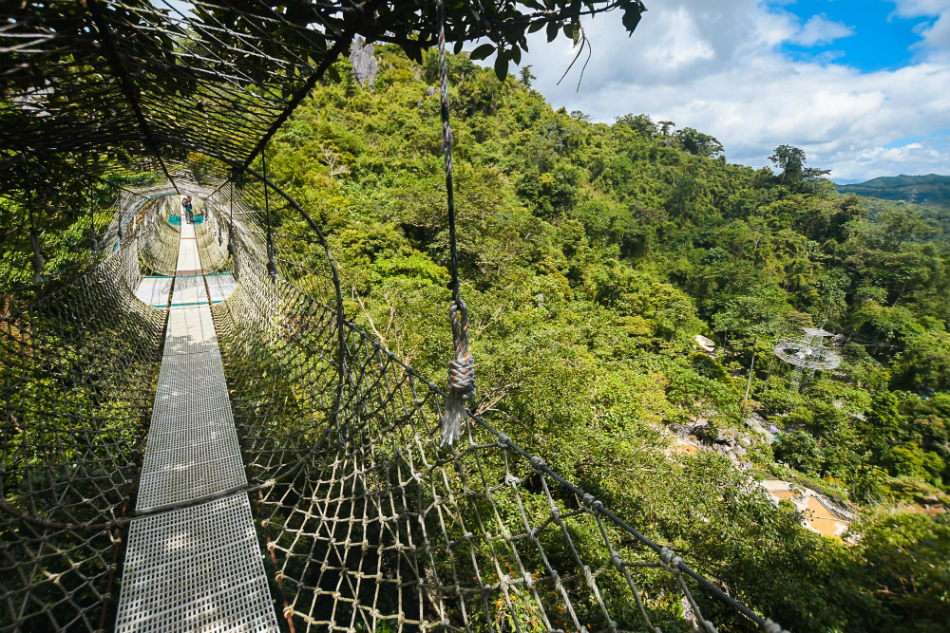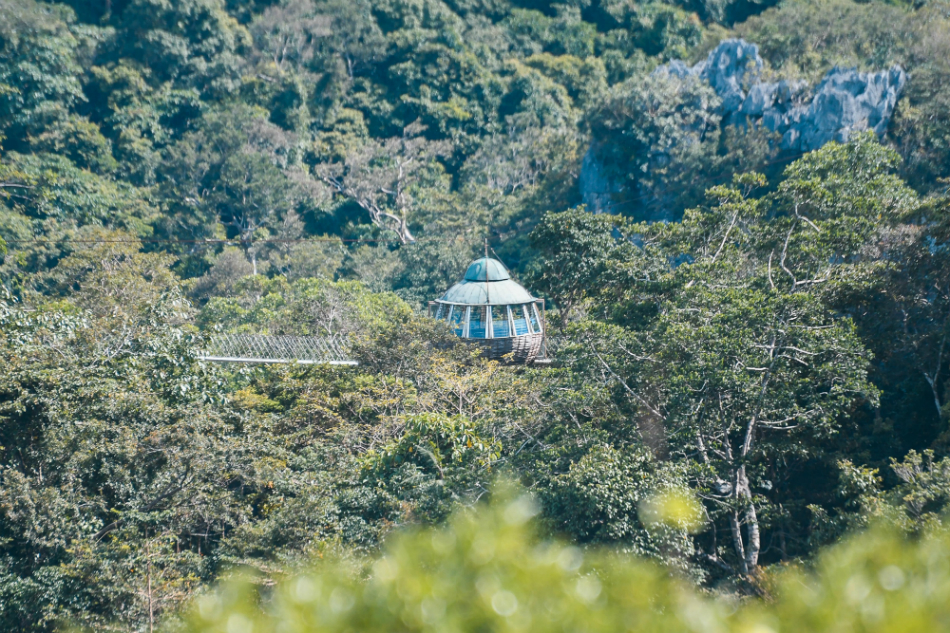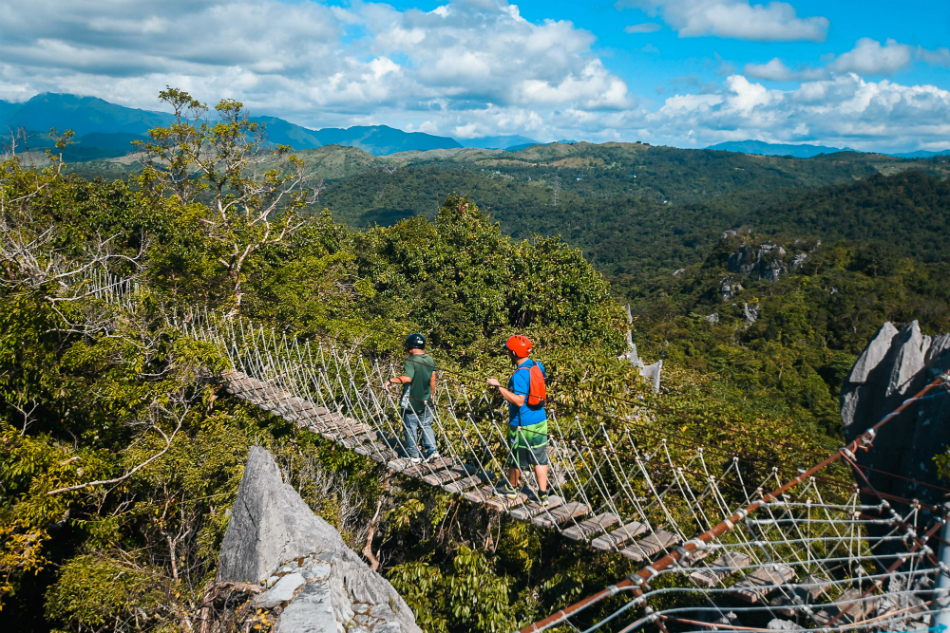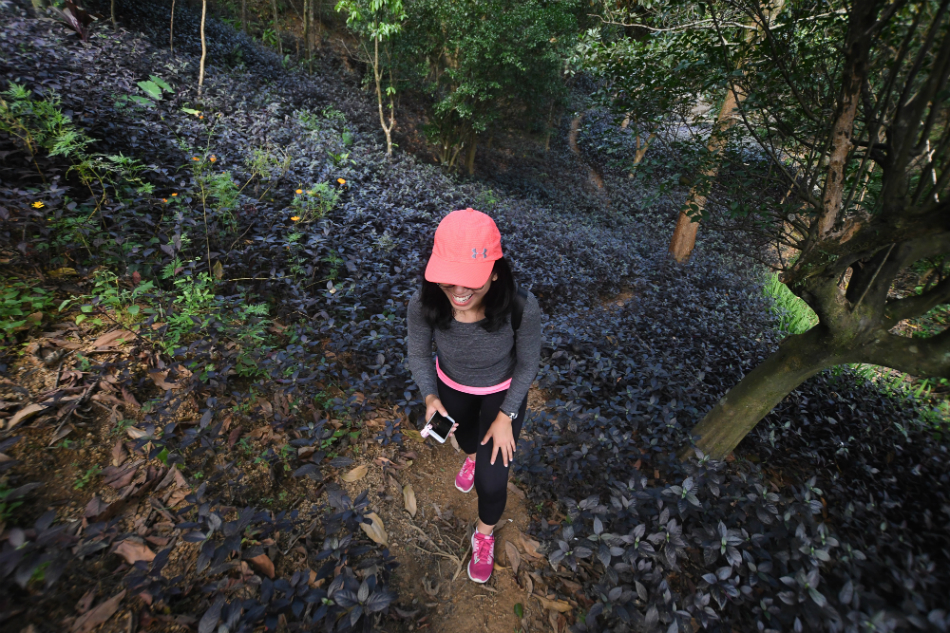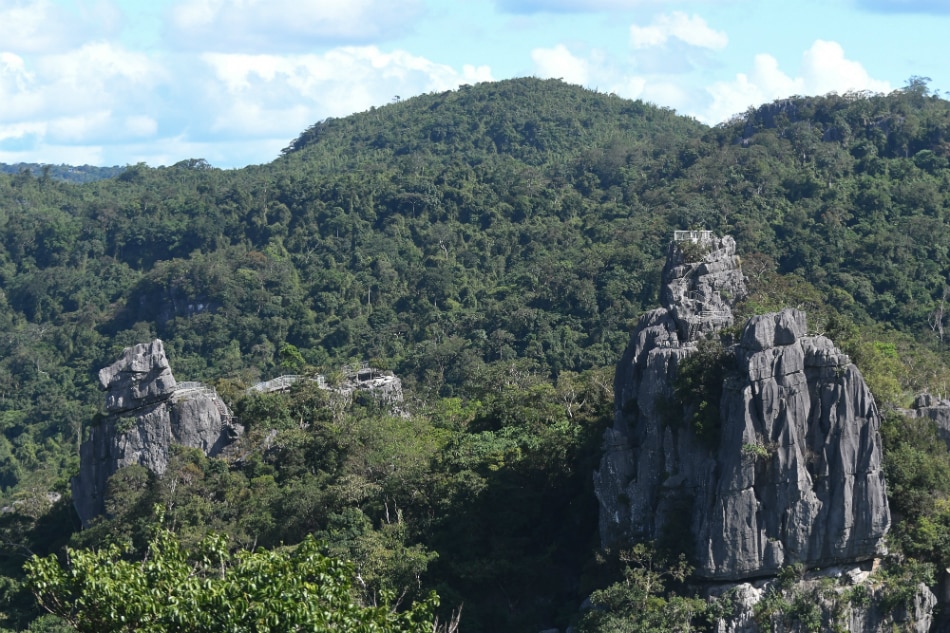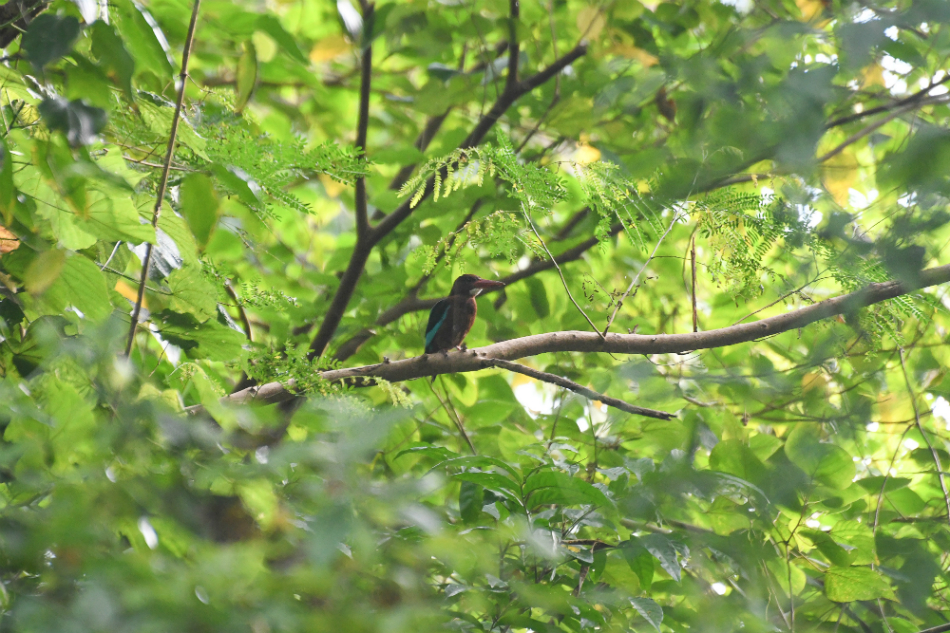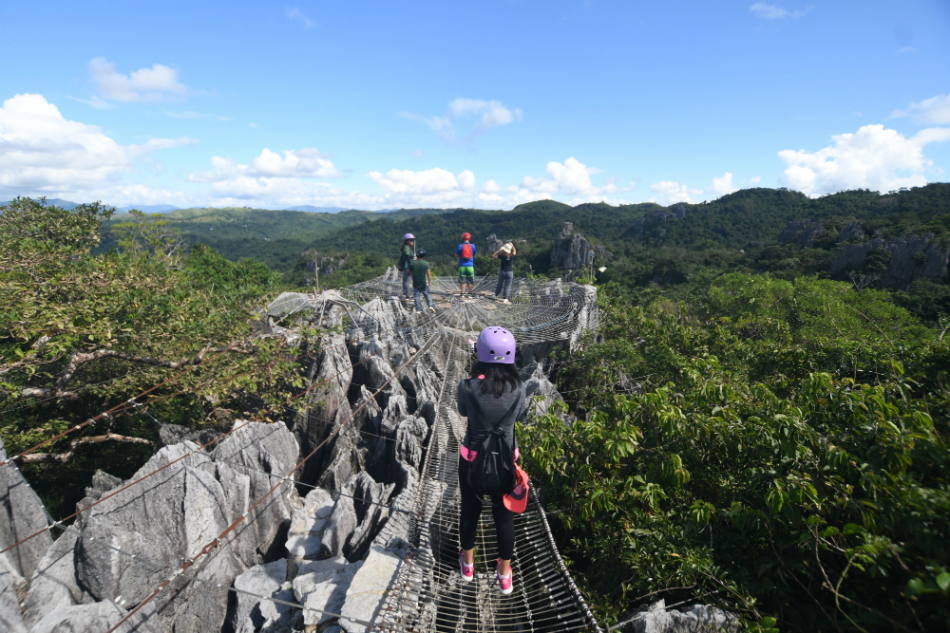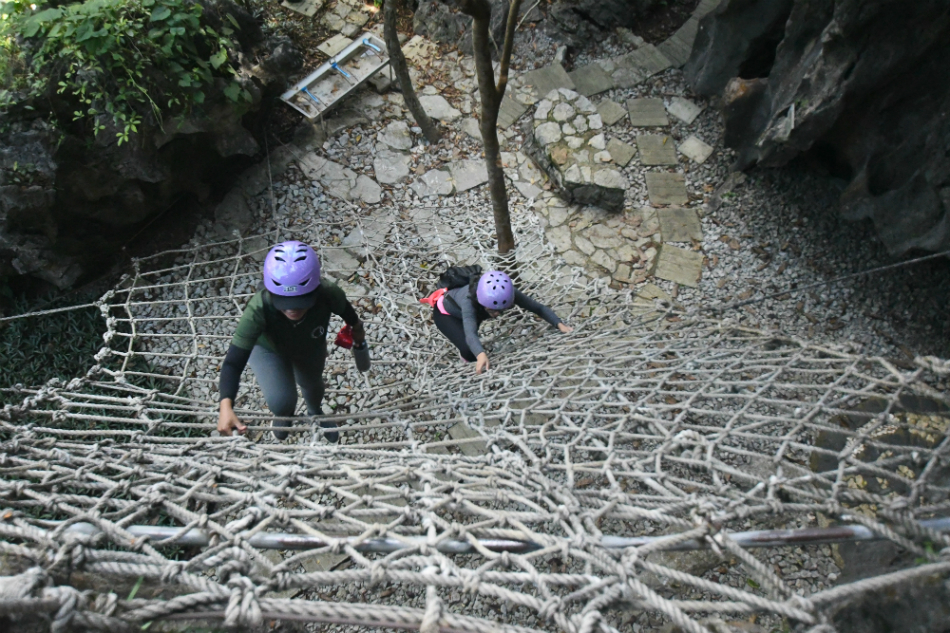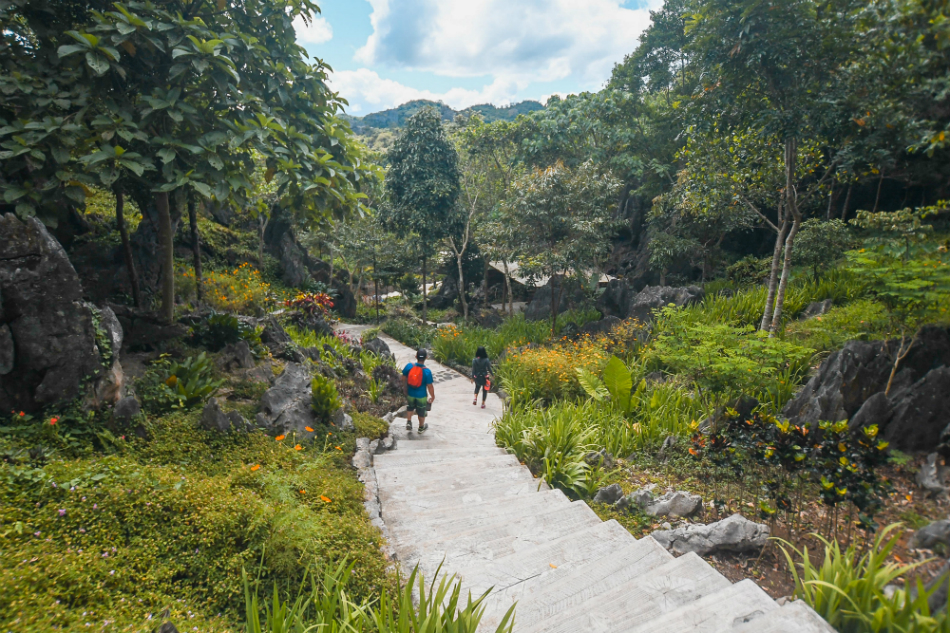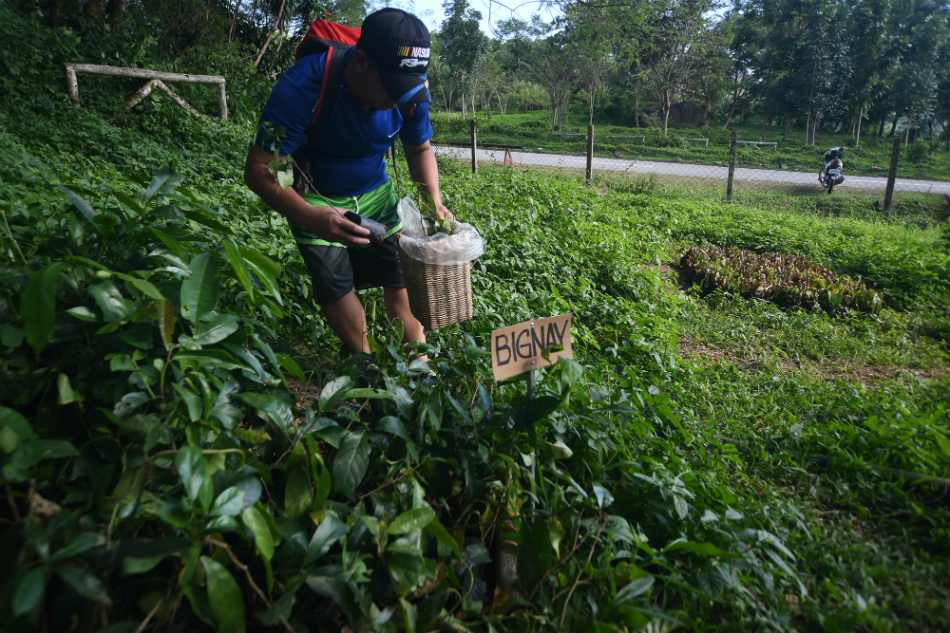Masungi Georeserve: Where former illegal loggers turn over new leaf in eco-tourism haven | ABS-CBN
ADVERTISEMENT

Welcome, Kapamilya! We use cookies to improve your browsing experience. Continuing to use this site means you agree to our use of cookies. Tell me more!
Masungi Georeserve: Where former illegal loggers turn over new leaf in eco-tourism haven
Masungi Georeserve: Where former illegal loggers turn over new leaf in eco-tourism haven
Kristine Sabillo,
ABS-CBN News
Published Nov 11, 2019 10:12 PM PHT
|
Updated Nov 13, 2019 03:44 PM PHT
Marcial Mendoza was just 13 years old when he started helping his father cut trees in the lush forests of Rizal, just fifty kilometers east of Manila.
Marcial Mendoza was just 13 years old when he started helping his father cut trees in the lush forests of Rizal, just fifty kilometers east of Manila.
“Isa kami sa mga kalaban o kaaway ng kalikasan kasi nag-illegal logging kami, nag-uuling. Nagpuputol ng mga punong kahoy,” the 21-year-old admitted.
“Isa kami sa mga kalaban o kaaway ng kalikasan kasi nag-illegal logging kami, nag-uuling. Nagpuputol ng mga punong kahoy,” the 21-year-old admitted.
(We were among the enemies of nature because we did illegal logging, burnt wood for charcoal, and cut trees.)
(We were among the enemies of nature because we did illegal logging, burnt wood for charcoal, and cut trees.)
Mendoza said they would cut down trees like kamagong, molave, and rosewood. They transported the timber by horse or carabao or, more often, by having the trunks float downhill through a river.
Mendoza said they would cut down trees like kamagong, molave, and rosewood. They transported the timber by horse or carabao or, more often, by having the trunks float downhill through a river.
ADVERTISEMENT
Mendoza, a member of the Dumagat tribe, said they did it for the money despite his tribe’s role in protecting the environment. But while a month’s work can earn them P50,000 a month per person, it can also be dangerous as some loggers have been crushed to death by falling trees.
Mendoza, a member of the Dumagat tribe, said they did it for the money despite his tribe’s role in protecting the environment. But while a month’s work can earn them P50,000 a month per person, it can also be dangerous as some loggers have been crushed to death by falling trees.
“Medyo mahirap ang trabaho, init, usok, lahat nandun hanggang sa nagkasakit na ang tatay ko,” Mendoza added, attributing his father’s stroke to illegal logging.
“Medyo mahirap ang trabaho, init, usok, lahat nandun hanggang sa nagkasakit na ang tatay ko,” Mendoza added, attributing his father’s stroke to illegal logging.
(The work is difficult. It’s hot, you get exposed to pollution and so my father got sick.)
(The work is difficult. It’s hot, you get exposed to pollution and so my father got sick.)
Following his late father’s advice, Mendoza left illegal logging and found work as a park ranger at the Masungi Georeserve in Baras, Rizal, which has become famous for its iconic rock formations.
Following his late father’s advice, Mendoza left illegal logging and found work as a park ranger at the Masungi Georeserve in Baras, Rizal, which has become famous for its iconic rock formations.
Nowadays, he serves as a guide for the conservation area’s “Legacy Trail” where he leads visitors through areas still undergoing reforestation. Here, he lectures about the harmful actions - from land grabbing to treasure hunting - that have damaged the forests of Rizal.
Nowadays, he serves as a guide for the conservation area’s “Legacy Trail” where he leads visitors through areas still undergoing reforestation. Here, he lectures about the harmful actions - from land grabbing to treasure hunting - that have damaged the forests of Rizal.
ADVERTISEMENT
Mendoza is just one of many locals who have come to understand the importance of preserving Rizal’s unique limestone landscape and the many endemic animal and plant species it shelters. Through Masungi Georeserve’s ecotourism program, locals and visitors are educated about the environment by participating and contributing to the park’s conservation and reforestation efforts.
Mendoza is just one of many locals who have come to understand the importance of preserving Rizal’s unique limestone landscape and the many endemic animal and plant species it shelters. Through Masungi Georeserve’s ecotourism program, locals and visitors are educated about the environment by participating and contributing to the park’s conservation and reforestation efforts.
SANCTUARY OF LIMESTONE
Masungi Georeserve is home to the Philippines’ only Paleocene age limestone, according to hydrogeologist Lea Bron who studied Masungi’s rock formations with the late renowned geologist Rolando Peña.
Masungi Georeserve is home to the Philippines’ only Paleocene age limestone, according to hydrogeologist Lea Bron who studied Masungi’s rock formations with the late renowned geologist Rolando Peña.
Bron explained that the 60-million-year-old sprawling landscape of limestone was once a pile of corals and shells that later fused together to form mountains of limestone. Over millions of years, through plate tectonics, the underwater formation eventually moved and was uplifted towards the present-day Philippines.
Bron explained that the 60-million-year-old sprawling landscape of limestone was once a pile of corals and shells that later fused together to form mountains of limestone. Over millions of years, through plate tectonics, the underwater formation eventually moved and was uplifted towards the present-day Philippines.
“Can you imagine how long that took and the massive amount (of corals and shells) that was needed to form it? I’m quite amazed,” Bron said of the 640-meter-high rock formations.
“Can you imagine how long that took and the massive amount (of corals and shells) that was needed to form it? I’m quite amazed,” Bron said of the 640-meter-high rock formations.
Other than its historical significance as the country’s only Paleocene limestone, Bron said its importance lies in the fact that it is a “sanctuary for plants and animals.”
Other than its historical significance as the country’s only Paleocene limestone, Bron said its importance lies in the fact that it is a “sanctuary for plants and animals.”
ADVERTISEMENT
“We always forget that biodiversity starts with the rocks,” she said. “If we don’t preserve these rocks we can’t preserve the flora and fauna.”
“We always forget that biodiversity starts with the rocks,” she said. “If we don’t preserve these rocks we can’t preserve the flora and fauna.”
Unfortunately, Rizal province has long been plagued not only by illegal logging but also mining and quarrying.
Unfortunately, Rizal province has long been plagued not only by illegal logging but also mining and quarrying.
Masungi Georeserve project manager Ann Dumaliang said when the Blue Star company first came in 20 years ago, the land was barren and there were a lot of private individuals claiming the area as their own. It was only in 2015 that the company founded Masungi Georeserve to continue its conservation, research and education efforts paired with ecotourism.
Masungi Georeserve project manager Ann Dumaliang said when the Blue Star company first came in 20 years ago, the land was barren and there were a lot of private individuals claiming the area as their own. It was only in 2015 that the company founded Masungi Georeserve to continue its conservation, research and education efforts paired with ecotourism.
Dumaliang explained that such limestone landscapes are “endangered” because of quarrying.
Dumaliang explained that such limestone landscapes are “endangered” because of quarrying.
She pointed out that while other people see rocks, Masungi’s limestone formations are “arcs of biodiversity” that contain unique species of plants and animals, some of which are found only in the Philippines.
She pointed out that while other people see rocks, Masungi’s limestone formations are “arcs of biodiversity” that contain unique species of plants and animals, some of which are found only in the Philippines.
ADVERTISEMENT
Among these are two species of the endemic cloud rat, 47 varieties of snails - among the highest in the country in terms of biodiversity - and 74 species of birds, some of them usually found deep within the Sierra Madre mountain region. Instead of residing in tree trunks, the frogs in Masungi find refuge inside the holes in the rocks.
Among these are two species of the endemic cloud rat, 47 varieties of snails - among the highest in the country in terms of biodiversity - and 74 species of birds, some of them usually found deep within the Sierra Madre mountain region. Instead of residing in tree trunks, the frogs in Masungi find refuge inside the holes in the rocks.
Researchers have visited the area to study the possibility of discovering new subspecies unique to Masungi. These include a jade vine that is of the color purple instead of green.
Researchers have visited the area to study the possibility of discovering new subspecies unique to Masungi. These include a jade vine that is of the color purple instead of green.
ECO-TOURISM
“Masungi Georeserve is at heart a conservation project with sustainable development and geotourism components,” said Dumaliang.
“Masungi Georeserve is at heart a conservation project with sustainable development and geotourism components,” said Dumaliang.
In recent years, however, the place has become popular among millennials who are attracted to its unique features and Instagrammable rope structures.
In recent years, however, the place has become popular among millennials who are attracted to its unique features and Instagrammable rope structures.
But Dumaliang said they originally created the trails for the park rangers who protected and monitored the area.
But Dumaliang said they originally created the trails for the park rangers who protected and monitored the area.
ADVERTISEMENT
She explained that putting up the web-style viewing platform dubbed “Sapot” (web) was actually the best way to provide their rangers a way to view the area without damaging the rocks below. It has since provided guests with an exhilarating view of Laguna Lake.
She explained that putting up the web-style viewing platform dubbed “Sapot” (web) was actually the best way to provide their rangers a way to view the area without damaging the rocks below. It has since provided guests with an exhilarating view of Laguna Lake.
“The rope courses were put up for practical and functional reasons,” she added. “They weren’t built to become Instagrammable.”
“The rope courses were put up for practical and functional reasons,” she added. “They weren’t built to become Instagrammable.”
Dumaliang said they were delighted that it has resulted in more people being interested in visiting the place.
Dumaliang said they were delighted that it has resulted in more people being interested in visiting the place.
Among the featured rope courses are bridges and cargo nets dubbed sawa (snake), duyan (hammock), and bayawak (large lizard). At the end of the three to four-hour trek, participants are given a certificate showing that they have collectively contributed to the planting and maintenance of a tree. For every day that the ecotourism site is open to the public, a new tree is planted in Masungi’s reforestation area.
Among the featured rope courses are bridges and cargo nets dubbed sawa (snake), duyan (hammock), and bayawak (large lizard). At the end of the three to four-hour trek, participants are given a certificate showing that they have collectively contributed to the planting and maintenance of a tree. For every day that the ecotourism site is open to the public, a new tree is planted in Masungi’s reforestation area.
With their increasing popularity in recent years, Masungi Georeserve has been able to not only support its ecotourism operations but also develop more conservation areas. Although the group says they cannot quantify the efforts and losses initially poured into the venture before it became an ecotourism site.
With their increasing popularity in recent years, Masungi Georeserve has been able to not only support its ecotourism operations but also develop more conservation areas. Although the group says they cannot quantify the efforts and losses initially poured into the venture before it became an ecotourism site.
ADVERTISEMENT
This year, Masungi Georeserve was recognized as one of the finalists of the United Nations World Tourism Organization Awards for Enterprises for its innovation and sustainable programs.
This year, Masungi Georeserve was recognized as one of the finalists of the United Nations World Tourism Organization Awards for Enterprises for its innovation and sustainable programs.
Recently, Masungi also opened its Legacy Trail, found across the highway, where visitors can learn more about the challenges faced by the country’s dwindling forests.
Recently, Masungi also opened its Legacy Trail, found across the highway, where visitors can learn more about the challenges faced by the country’s dwindling forests.
“You will get to experience what it is like to restore our forest,” Dumaliang said. “It’s immersion and restoration.”
“You will get to experience what it is like to restore our forest,” Dumaliang said. “It’s immersion and restoration.”
At the entrance of the trail, participants are given baskets to carry seedlings that they will plant themselves when they reach Gina’s Grove, which was named after the late Environment Secretary Gina Lopez.
At the entrance of the trail, participants are given baskets to carry seedlings that they will plant themselves when they reach Gina’s Grove, which was named after the late Environment Secretary Gina Lopez.
Visitors are then guided through the forest where they can see deep holes left by bogus treasure hunters and barren areas that once suffered ravaged by illegal logging.
Visitors are then guided through the forest where they can see deep holes left by bogus treasure hunters and barren areas that once suffered ravaged by illegal logging.
ADVERTISEMENT
PROTECTING FORESTS
Dumaliang said they hope to instill among their visitors and staff the importance of reforestation.
Dumaliang said they hope to instill among their visitors and staff the importance of reforestation.
“Reforestation of our forests is one of the fastest ways to address climate change, which leads to water scarcity, lack of access to a lot of resources for forest-based communities,” she said.
“Reforestation of our forests is one of the fastest ways to address climate change, which leads to water scarcity, lack of access to a lot of resources for forest-based communities,” she said.
According to the Forest Management Bureau, the Philippines loses an average of 47,000 hectares of forest cover every year.
According to the Forest Management Bureau, the Philippines loses an average of 47,000 hectares of forest cover every year.
Dumaliang said only 25 percent of the Philippines’ forest cover is left, with only three percent as virgin forests or those not affected by human intervention.
Dumaliang said only 25 percent of the Philippines’ forest cover is left, with only three percent as virgin forests or those not affected by human intervention.
Park ranger Jason Viado said he grew up in Rizal province, thinking that it is the way of life for many people to cut and burn trees.
Park ranger Jason Viado said he grew up in Rizal province, thinking that it is the way of life for many people to cut and burn trees.
ADVERTISEMENT
“It’s what they need to do to survive,” he recalled thinking.
“It’s what they need to do to survive,” he recalled thinking.
But Viado, who now trains fellow forest rangers, has realized why locals should also be educated about conserving forests.
But Viado, who now trains fellow forest rangers, has realized why locals should also be educated about conserving forests.
“It’s only now that I realized that what they are doing is not good. We (humans) are destroying the shelter of animals,” he said, lamenting that many species might soon become endangered.
“It’s only now that I realized that what they are doing is not good. We (humans) are destroying the shelter of animals,” he said, lamenting that many species might soon become endangered.
“We’ll also be affected because we’ll lose our source of water and we’ll suffer from the heat resulting from the lack of trees in our communities,” Viado said.
“We’ll also be affected because we’ll lose our source of water and we’ll suffer from the heat resulting from the lack of trees in our communities,” Viado said.
With its successful take on ecotourism, Masungi Georeserve hopes to not only makes tourists ponder on the beauty and importance of nature but also to spur greater change by helping other conservation groups.
With its successful take on ecotourism, Masungi Georeserve hopes to not only makes tourists ponder on the beauty and importance of nature but also to spur greater change by helping other conservation groups.
ADVERTISEMENT
At the same time, “The ultimate goal is to instill pride of place among the locals, among all Filipinos, so that they understand why this place is part of our identity as a people and what is so different and what is so valuable about it,” Dumaliang said.
At the same time, “The ultimate goal is to instill pride of place among the locals, among all Filipinos, so that they understand why this place is part of our identity as a people and what is so different and what is so valuable about it,” Dumaliang said.
ADVERTISEMENT
ADVERTISEMENT



